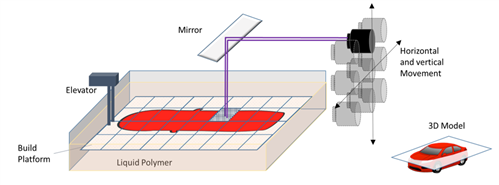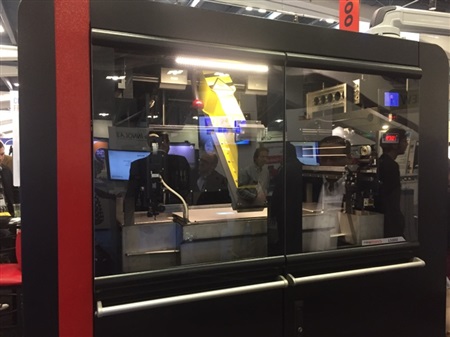SSZTBK3 march 2016 DLP9500UV
I recently returned from the Photonics West show in San Francisco, where my company, Prodways, displayed our industrial 3D printer alongside Texas Instruments DLP® Products. Our product was included with demos for spectroscopy, machine vision, 3D scanning and other 3D printing applications. It was exciting to see how DLP technology is used in many applications in the industrial space.
The flexibility of DLP chipsets was a major reason why we chose it as a key component for our Prodways ProMaker L5000 3D printer, which uses patented MOVINGLight® technology and the DLP9500UV chipset. Let’s look into both of these technologies a bit more closely.
Prodways’ Movinglight® technology explained
This technology is a photopolymerization process for rapidly producing prototypes, functional parts or end use manufacturing components with very high resolution. It works by polymerizing photosensitive resins with DLP technology’s ultraviolet (UV) rays.
Thanks to its unique 365 nanometer wavelength, the UV polymerization of liquid or paste materials charged with ceramic, metal, fiber or nanoparticles provides us with the means to meet a wide range of industrial and medical additive manufacturing needs. Some applications include jewelry parts, dental models, hearing aids, footwear molds and investment casting patterns.
 Figure 1 This diagram shows how MOVINGLight® technology is moving the DLP technology projected image over the build area
Figure 1 This diagram shows how MOVINGLight® technology is moving the DLP technology projected image over the build areaAdvantages of DLP Technology
The high speed and accuracy of DLP technology is a big competitive advantage for our product and industrial 3D printing overall. Our printer uses a fast DLP chip, paired with a high-powered LED, to project an image onto a large, liquid surface. In this process, the resin is cured into a solid part.
While this process is similar to other 3D printing technologies available today, we have the benefits of speed and high precision due to the DLP technology used. The spot size of the projected image is about 40 microns, which is extremely precise. We also can draw this small spot size with a very large imaging field of 70 x 40 millimeters.
 Figure 2 The Prodways ProMaker L5000 3D printer at Photonics West
Figure 2 The Prodways ProMaker L5000 3D printer at Photonics WestWhere We’re Headed
The combination of MOVINGLight® technology and DLP technology could positively impact the market by providing a cost effective return of investment to the owner. By using LED technology, this cost of ownership is already reduced compared to some existing solutions. Because manufacturers are able to print multiple objects at one time, the printing process takes less time while yielding high volumes.
As we consider what’s possible for 3D printing, our goal is to move from making prototypes to manufacturing real solutions that can be immediately used in production. Overall, we’re just excited to see where industrial 3D printing goes in the coming years – the future is certainly looking bright!
Ready to start designing your own solution with DLP technology? Be sure to check out their TI Designs Reference Design for 3D printing here.